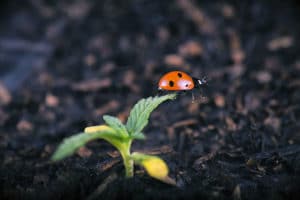More and more New Zealand farmers are planting a crop that they were banned from growing for eight decades or so.
They are setting aside land to raise hemp, for use in cereals, oils and textiles.
It’s still very much in its infancy, but for some, hemp is seen as a useful crop to offer diversity on the farm.
As big money flows into medicinal cannabis, and with the upcoming referendum on recreational cannabis use, hemp’s profile is rising — even though it is far removed from the narcotic strain that gets all the attention.
Proponents wax lyrical about hemp’s many uses — everything from hemp oil for joint health through to “hempcrete” for construction. To its backers, hemp really is the miracle plant.
They say the plant can also offer benefits to the landowner, through its ability to lock up carbon.
Research into growing hemp in New Zealand started in 2006, and the regulations covering the crop were amended at the end of 2018.
In that time an industry has built up, particularly around hempseed and oil.
While it is very much a fringe land use, it is growing in popularity among farmers.
Dave Jordan, who heads the biggest player Hemp NZ and its subsidiary Hemp Farm, says barely a day goes by without an inquiry from a farmer looking to plant.

Photo / Mark Mitchell
Today, the legality of industrial hemp varies widely between countries. Some governments, New Zealand included, regulate the concentration of THC — the chemical responsible for many of marijuana’s psychological effects — and permit only hemp that is bred with an especially low THC content. Hemp Farm will soon branch out into the hemp fibre business, having just imported a machine called a decorticator to process it. The company has formed a joint venture with New Zealand Yarn — in which it has a holding — and the two plan to make a hemp yarn which will initially be spun with wool to make a blended wool-hemp carpet. The process involves the production of hemp “hurd” — the woody refuse left over after the fibres are extracted. In turn, that hurd is used to make hempcrete, a substitute for concrete. “Obviously, hemp fibre has a lot of other uses in textiles, insulation products and matting to help deal with soil erosion,” Kite says. “There is a massive opportunity there. “In fact it probably has more potential than the food side.” Cookie Time founder and serial entrepreneur Michael Mayell talks big when it comes to hemp. He points that out industrial hemp is the fastest growing crop in US agriculture. The US, like New Zealand, defines industrial hemp as cannabis sativa plants containing 0.3 per cent or less THC. If levels go over that, the plants are considered marijuana.
Cookie Time founder Michael Mayell. Photo / Supplied
A “yes” in the recreational cannabis referendum may see the outdated rules around hemp rewritten. “It will unleash the biggest economic opportunity that New Zealand has ever seen,” says Mayell. “This is a massive opportunity that this country can take advantage of, at the very time that we need it.” He sees hemp’s potential as an alternative land use as the most exciting prospect. “It is naturally pest resistant, so if you want to move to regenerative agriculture, it’s about dialling down stock numbers and dialling up the plant numbers. “This could be the solution to many problems,” says Mayell. “We just have to get over the stigma.” Seeds and oil are currently the biggest focus for New Zealand hemp companies. Photo / Supplied
Others include Hemp Connect, Kanapu Foods, Kakariki Foods, Midlands Seed, Midland Nutritional Oils, NZ Hempress, Brothers Green and Larry’s Gold.
The compound CBD, which is mainly used in pain management, has been the main driver of capital investment in the United States.
“The future of hemp fibre is very positive both domestically and internationally,” Hemp NZ says.
The organisation says it has identified three “megatrends “:
Seeds and oil are currently the biggest focus for New Zealand hemp companies. Photo / Supplied
Others include Hemp Connect, Kanapu Foods, Kakariki Foods, Midlands Seed, Midland Nutritional Oils, NZ Hempress, Brothers Green and Larry’s Gold.
The compound CBD, which is mainly used in pain management, has been the main driver of capital investment in the United States.
“The future of hemp fibre is very positive both domestically and internationally,” Hemp NZ says.
The organisation says it has identified three “megatrends “:
Paris Accord
“With all this concern about the environment and the Paris Accord on climate change, and the focus on plastics and so forth, the world is changing and it’s coming to meet us,” Jordan says. “It’s not really fringe in terms of it being something new. It’s just something that has been rediscovered. “We are restoring it to its rightful place in the economy. “Because it has been criminalised or outlawed for so many years, the current generation don’t know about it, so it’s a matter of rediscovering and re-educating,” he says. “It offers fibre, health, wellbeing and solutions to environmental challenges that we are all facing. “We have got a changing world. With people getting into vegetarianism, plant-based food products and wanting a better environment, hemp offers solutions to all those things. Dave Jordan, chief executive of Hemp NZ and its subsidiary Hemp Farm. Photo / Supplied Typically, says Jordan, farmers are looking at setting aside 20 to 50 hectares for hemp growing. Hemp Farm started harvesting hemp on 53 hectares in 2014. The following year, the area nearly tripled to 150ha. By 2018 the harvest came from 470ha and last year that figure almost tripled again to 1300ha. Jordan now works with 70 growers, most of them in Canterbury, Waikato and Wairapapa.Research and development
“The thing about this crop is that it has been in jail for so long that bringing it back out and putting it back on the table means that there will be a lot more research and development going on with all of us,” Jordan says. For years, hemp has been lumped in with the psychoactive, high-THC strain of cannabis. Now it is used in cereals for some well-known brands, in baking products and health foods. As a land use, it is seen as a good rotation crop. “There is a lot of interest in the crop,” Jordan says. “I do see a big growth curve coming, especially since the world is more and more getting into health and wellbeing, especially after Covid.” Hemp Farm processes hemp at Tauriko, near Tauranga. There, the company extracts hemp oil from the seeds and makes bulk product to supply other companies with ingredients used in some well-known brands of cereals and baking products. As Hemp Farm’s general manager Leigh Kite sees it, the industry has been battling misconceptions for years. “The word ‘cannabis’ is very emotionally charged,” she says. “People’s minds go instantly to recreational use of marijuana, or weed, or whatever you want to call it. “There is more to the plant than that.”Hemp fibre
While hemp seds yield oil, the stalk of the product is where the fibre comes from. In the past, that fibre was an essential material for making sails and rope for ships. These days the main use is for hemp oil — extracted from the seeds and packaged in capsule form — for use treating joint ailments. The de-hulled seeds are used in snack bars and cereals. “The current generation doesn’t know about it, so it’s a matter of rediscovering and re-educating,” says Kite. Hemp, or industrial hemp, is a variety of the Cannabis sativa plant species that is grown specifically for the industrial uses of its derived products. It is one of the fastest growing plants and was one of the first plants to be spun into usable fibre. Hemp can be refined into a variety of commercial items, including paper, textiles, clothing, biodegradable plastics, paint, insulation, biofuel and food — for people and animals. Prime Minister Jacinda Ardern tasting hemp protein ice cream during her visit to FoodPilot in Palmerston North.
Photo / Mark Mitchell
Today, the legality of industrial hemp varies widely between countries. Some governments, New Zealand included, regulate the concentration of THC — the chemical responsible for many of marijuana’s psychological effects — and permit only hemp that is bred with an especially low THC content. Hemp Farm will soon branch out into the hemp fibre business, having just imported a machine called a decorticator to process it. The company has formed a joint venture with New Zealand Yarn — in which it has a holding — and the two plan to make a hemp yarn which will initially be spun with wool to make a blended wool-hemp carpet. The process involves the production of hemp “hurd” — the woody refuse left over after the fibres are extracted. In turn, that hurd is used to make hempcrete, a substitute for concrete. “Obviously, hemp fibre has a lot of other uses in textiles, insulation products and matting to help deal with soil erosion,” Kite says. “There is a massive opportunity there. “In fact it probably has more potential than the food side.” Cookie Time founder and serial entrepreneur Michael Mayell talks big when it comes to hemp. He points that out industrial hemp is the fastest growing crop in US agriculture. The US, like New Zealand, defines industrial hemp as cannabis sativa plants containing 0.3 per cent or less THC. If levels go over that, the plants are considered marijuana.
US trend
Before 2015, hemp in the US was virtually nonexistent as a commercial crop because it was lumped in with marijuana. The law changed in 2014 and the following year 1500 acres of hemp were planted in the US. Today, nearly 100 times that area is planted in hemp, according to the US Department of Agriculture. Mayell, who these days likes to invest in environmental projects, says hemp could become useful as a gateway to regenerative agriculture, which aims to build up the soil quality. “There are many who believe that we will not move to regenerative agriculture without hemp,” he says. “And when you consider that an acre of hemp breathes in four times the carbon dioxide and breathes out four times as much oxygen per acre of trees.”
Cookie Time founder Michael Mayell. Photo / Supplied
A “yes” in the recreational cannabis referendum may see the outdated rules around hemp rewritten. “It will unleash the biggest economic opportunity that New Zealand has ever seen,” says Mayell. “This is a massive opportunity that this country can take advantage of, at the very time that we need it.” He sees hemp’s potential as an alternative land use as the most exciting prospect. “It is naturally pest resistant, so if you want to move to regenerative agriculture, it’s about dialling down stock numbers and dialling up the plant numbers. “This could be the solution to many problems,” says Mayell. “We just have to get over the stigma.”
A $2b local industry by 2030?
Hemp New Zealand estimates that the industry could be worth $2 billion to this country by 2030, creating 20,000 regional jobs. The growing and manufacture of hemp products was for centuries a key economic sector from Asia to the Americas. “But it was followed by eight decades of being wrongly designated as a narcotic drug,” Hemp NZ says. “With the trend of changes to legislation occurring in many countries, the industry has had a resurgence of investment. “It now has the potential to occupy again the high level of national economic value it once occupied through industrial fibre products, textiles, and natural health remedies,” it says in an investment report. Today, the leading hemp-growing countries are China, Canada, the United States, France, Chile and North Korea. HempBioFiber in Canada makes hemp bricks for construction. Photo / Bloomberg Hemp NZ says the global industry has enjoyed a compound annual growth rate of 20 per cent over the past four years, but is projected to grow even more quickly — US$4.6 billion in 2019 to US$64.8b by 2030. The biggest share of this market is expected to be the extract — cannabidiol (CBD) — and cannabinoid products, as well as fibre products. “New Zealand companies are beginning to export the premium seed oils category for the discerning global consumers in the major cities of the world,” says the report. “This will be followed by fibre exports as processing plants are built, and cannabinoid nutraceuticals as and when they are legalised in New Zealand.” Hemp NZ says the local industry has experienced rapid growth over the past 24 months, with a number of companies being established. The main focus so far has been hemp seed and oil for the domestic market, with strong online sales to meet demand for new natural health foods. Hemp NZ estimate that at least 1200ha to 1500ha of hemp was farmed in the 2019-20 season. Food manufacturers are adding hemp ingredients to existing and new branded foods and beverages, it says. Online retailers, supermarket and health food food chains are selling hemp seed foods. The industry is also drawing in agri-tech companies, contract processors, testing companies and extracting companies. The sector also includes vertically integrated businesses — companies that grow, process and sell hemp products. The most recognised of those companies are Hemp NZ and its subsidiary Hemp Farm. Seeds and oil are currently the biggest focus for New Zealand hemp companies. Photo / Supplied
Others include Hemp Connect, Kanapu Foods, Kakariki Foods, Midlands Seed, Midland Nutritional Oils, NZ Hempress, Brothers Green and Larry’s Gold.
The compound CBD, which is mainly used in pain management, has been the main driver of capital investment in the United States.
“The future of hemp fibre is very positive both domestically and internationally,” Hemp NZ says.
The organisation says it has identified three “megatrends “:
Seeds and oil are currently the biggest focus for New Zealand hemp companies. Photo / Supplied
Others include Hemp Connect, Kanapu Foods, Kakariki Foods, Midlands Seed, Midland Nutritional Oils, NZ Hempress, Brothers Green and Larry’s Gold.
The compound CBD, which is mainly used in pain management, has been the main driver of capital investment in the United States.
“The future of hemp fibre is very positive both domestically and internationally,” Hemp NZ says.
The organisation says it has identified three “megatrends “:
- The move to regenerative agriculture and sustainability. • Demand for hemp and CBD in the drive for natural health solutions. • Plans to replace meat and dairy with plant based substitutes.
- Hemp is the name given to cannabis sativa plant strains with extremely low levels of THC — the compound that produces recreational marijuana’s narcotic effect. • Grown in New Zealand and overseas for industrial and commercial use. • In New Zealand, the allowed level of THC is less than 0.35 per cent. • Seed is highly nutritious and very versatile. • The entire hemp plant, including stalk, leaves, seeds and buds, can be used for a wide range of products including fibre, food and health remedies.
- Hemp manufacturing was for centuries a key economic sector, from Asia to the Americas. • But this was followed by eight decades of being wrongly lumped in with its recreational cousin. • Today, the leading hemp producing countries are China, Canada, the US, France, Chile and North Korea.
- The global hemp industry has been growing at a compound annual growth rate of 20 per cent over the past four years, and is projected to grow from US$4.6 billion in 2019 to US$64.8b by 2030. • In this country, Hemp New Zealand has forecast that the domestic industry could be worth $2b by 2030, creating 20,000 jobs.
- Amendments to the Misuse of Drugs Act in 2018 allowed cultivation of low-THC industrial hemp, and processing and trading in the seeds and stalk to produce hemp food and fibre products. • Medicinal cannabis was made legal, under prescription, on April 1 this year. • The cultivation of hemp is permitted in New Zealand for the production of hempseed oil and hemp seeds, as well as for fibre. • Products containing cannabidiol — one of many natural compounds found in the cannabis plant — are regarded as prohibited by the regulator, the Ministry of Health.




